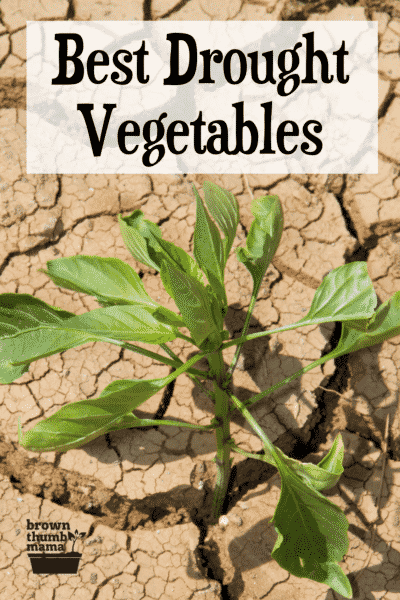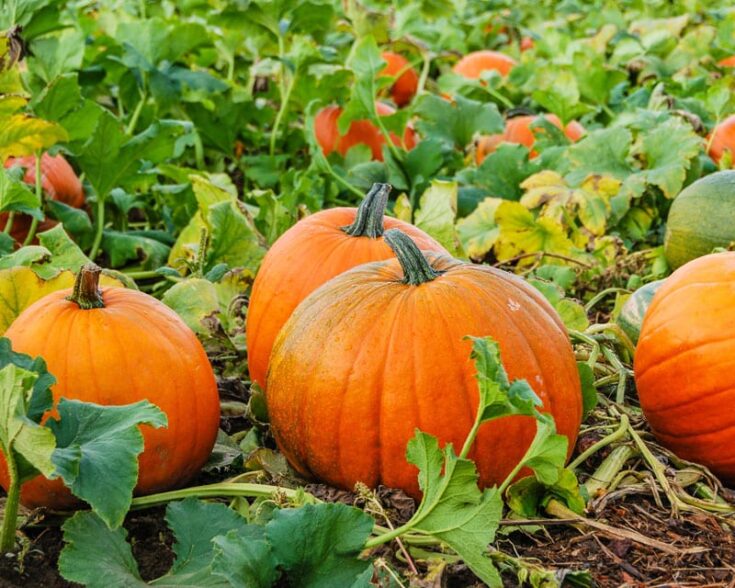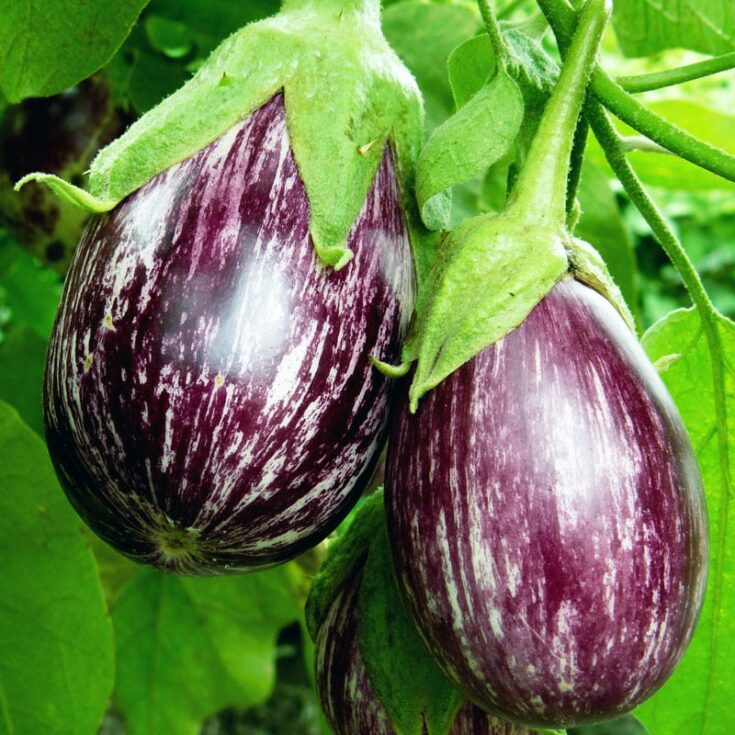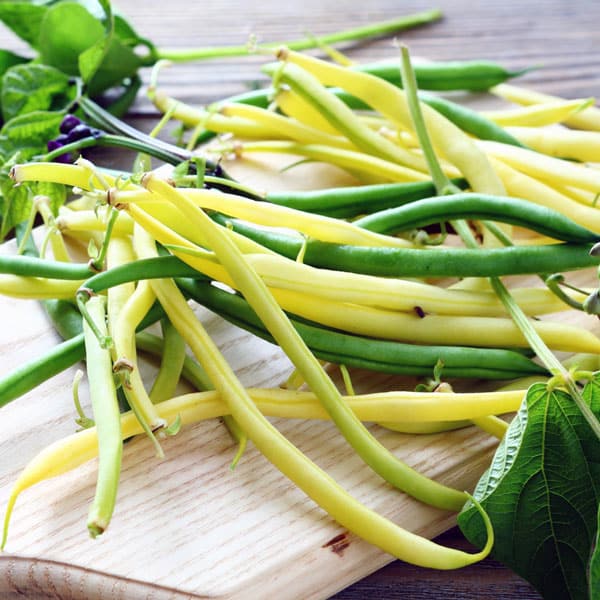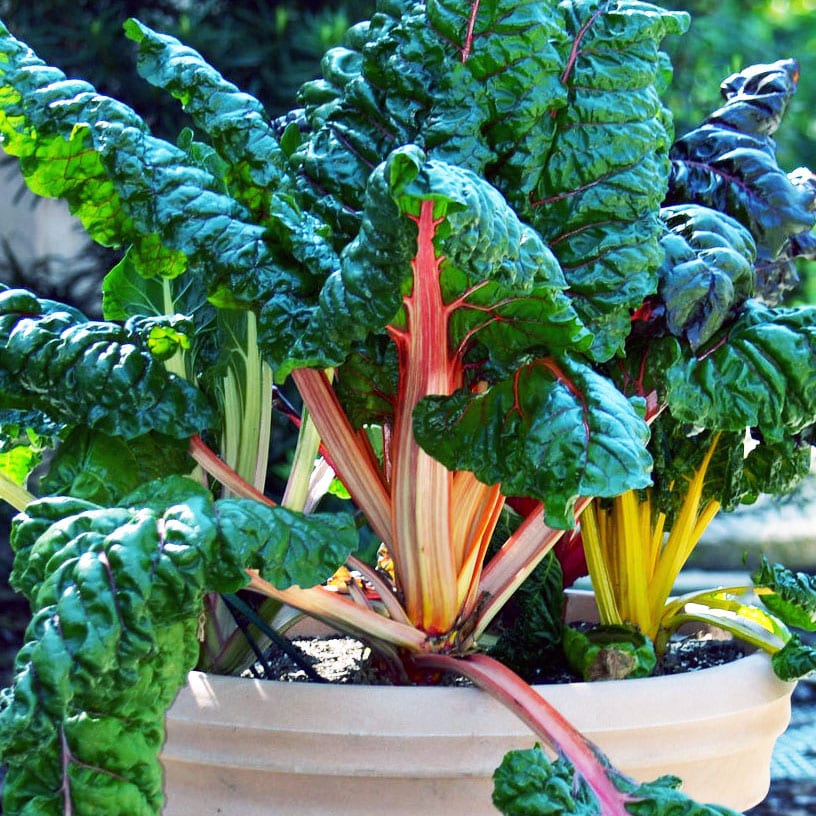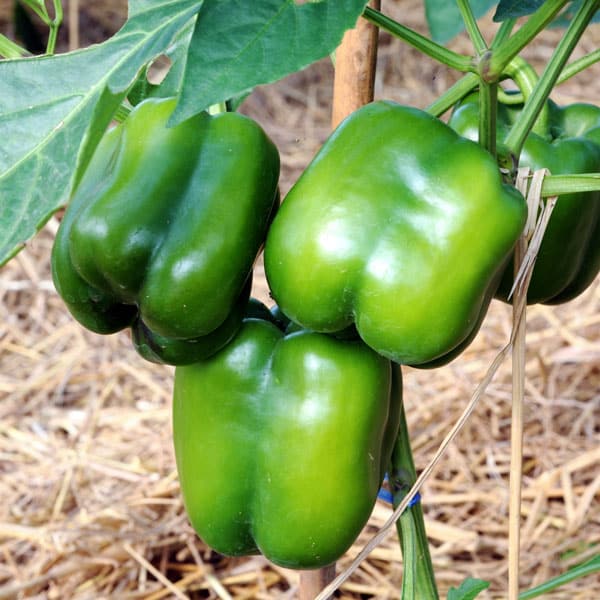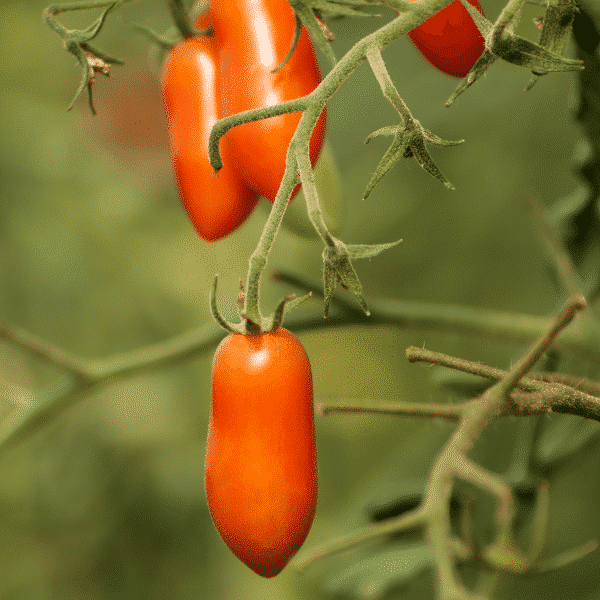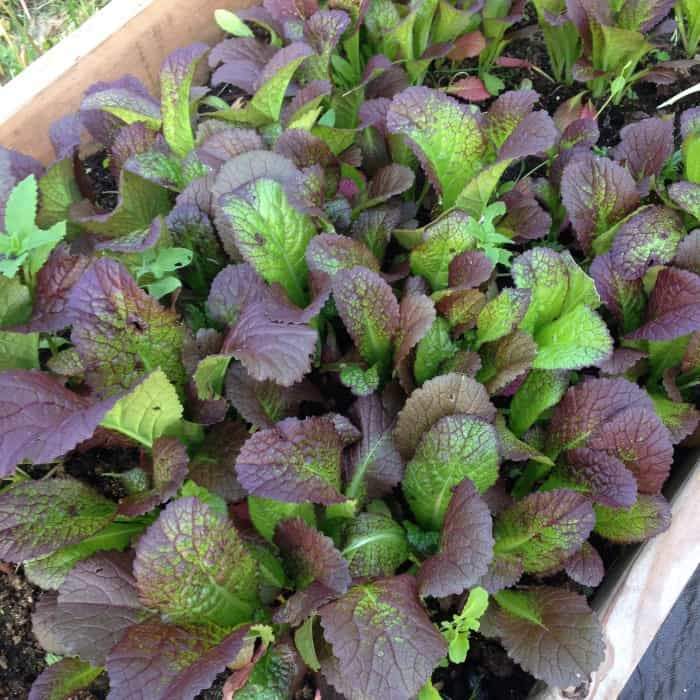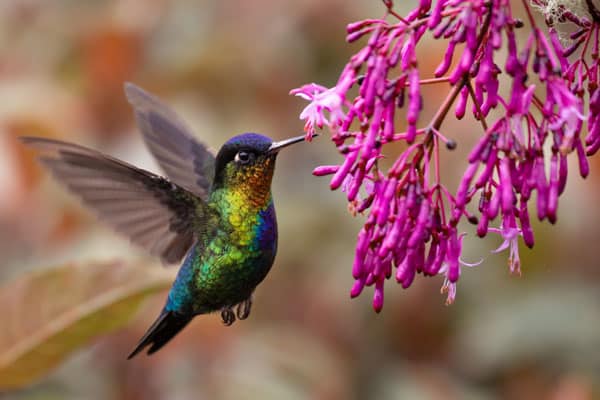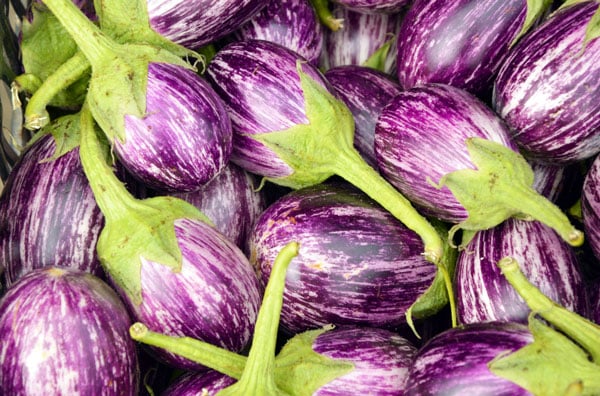This post may include affiliate links.
If you make a purchase, I'll earn a small fee at no extra cost to you.
Yes! You can grow a vegetable garden in a drought or with low water conditions. Here are 7 drought-tolerant vegetables, including recommended varieties and planting tips.
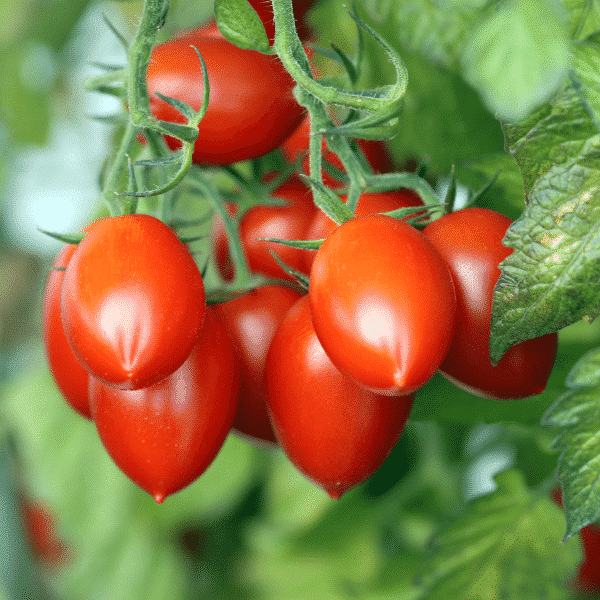
You may have heard that here in California, we don’t have enough water to wet our whistle. There’s no snow, lakes are drying up, and severe water restrictions are in place.
We aren’t the only ones! Many gardeners across the US are making do with less water because of cost, conservation, or personal choice.
Don’t fret. If you’re reducing your water use, you can still have a great vegetable garden! There are many vegetables you can grow in a drought, and I also recommend growing herbs indoors to save water.
Are you a brand new gardener? Not sure what to plant or when to plant it? I can help.
You’ll find lots of great information in my new book, The First-Time Gardener: Container Food Gardening.
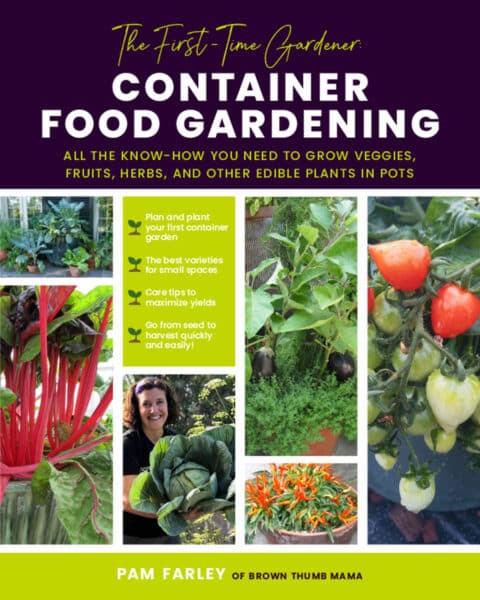
Finding Drought-Tolerant Vegetables
Some vegetables, like cucumber and watermelon, need lots of water to grow and thrive. So how do you find vegetables that will grow in drought conditions? Here are some tips:
- Look for varieties that are fast-maturing (are ripe in fewer days than other types). These will be ready to eat sooner, so you’ll water less often.
- Plants that originate in a Mediterranean climate can handle drought.
- Consider low-water, perennial vegetables and fruits, like asparagus, pomegranate, or grapes.
- Determinate varieties, like Roma tomatoes, ripen all at once and are done producing. You can pull the plant after fruiting, and no longer need to water it. What’s a determinate variety? Learn more here.
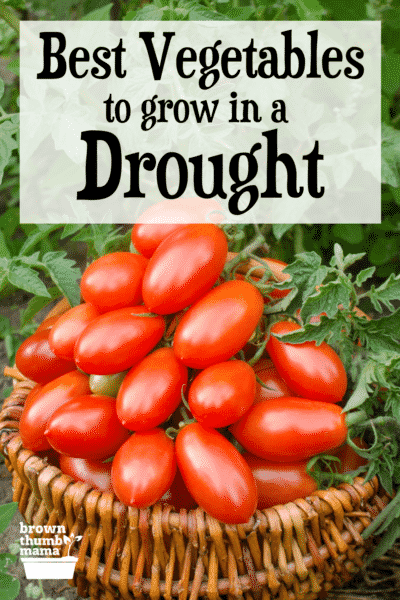
Best Vegetables to Grow in a Drought
Pumpkins are easy to grow from seed, and there are many different types--teeny decorative pumpkins, white pumpkins, carving pumpkins, pumpkins for making pies, novelty pumpkins covered in warts...it’s hard to decide.
Varieties: I like to grow Howden pumpkins for making jack-o-lanterns, and Lumina, which are white pumpkins, to surprise the kids.
Planting: Pumpkins are easy to grow and need lots of space. Here are my tips on growing and planting pumpkins.
Recipe: Once you harvest your pumpkins, save the seeds and make Roasted Pumpkin Seeds.
Eggplant (also called aubergine) is a veggie that likes hot weather, just like tomatoes and peppers. All three of these plants are part of the Nightshade family. And did you know that eggplants can be purple, white, green, or even orange?
Varieties: Listada de Gandia is a beautiful French heirloom eggplant. Black Beauty is another favorite for its large size and thin skin that you don't have to peel.
Planting: Plant seedlings 18 inches apart--happy eggplants grow into bushes nearly 2 feet tall and 16 inches wide. Stake them shortly after planting, or the weight of the eggplants will cause the plant to fall over. Learn more about planting and growing eggplant.
Recipe: Eggplant is delicious when sliced, brushed with olive oil, and grilled until just soft.
I always get carried away when planting green beans. There are so many different varieties to try! Calling them “green” beans is not completely correct--there are yellow beans and even purple beans.
Beans grow on two different types of plants. Bush beans, as you can guess, grow on a bushy plant that doesn’t need a support. They produce earlier and have a shorter harvest period, which is better for growing with low water.
Pole beans grow on a vine, and need a trellis or some other support. They produce later but produce beans over a longer period of time.
Varieties: Blue Lake bush beans are the most common type of green bean, and they have excellent flavor. You can also get Blue Lake pole beans if you prefer to grow them vertically.
My favorite yellow bean (sometimes called wax bean) is Gold Rush bush bean. The slender beans grow in clusters and are easy to see and pick.
Who doesn’t love a purple bean? I like Royal Burgundy bush beans because of their beautiful color and great flavor. Kids love them, and they turn green when cooked!
Planting: Beans are usually direct sowed in the garden. Pole beans will climb, so they need a pole or trellis. Bush beans are great in containers or in raised beds. Both varieties appreciate a scoop of your homemade compost mixed in with the soil when planting.
Recipes: It's easy to have some huge harvests of beans from the garden. Here's my super easy technique for freezing green beans so you can enjoy the harvest all year long.
Chard is a vegetable that thrives with very little attention (or water). It grows vigorously, provides a continuous harvest, and can even survive the winter in mild climates. Ideal, right? Except that if you’re the only person in your family who likes to eat Swiss chard, you will quickly be overrun with it. Ask me how I know.
Varieties: Warnings aside, I like Bright Lights Chard and Five Color Chard because they’re both beautiful and colorful. You could even plant these as ornamentals in your front yard!
Planting: Direct seed in the spring or fall, and you’ll be harvesting in 60 days. Learn more about how to grow Swiss chard.
Recipe: I like to chop chard leaves into tiny bits and add it to Baked Italian Meatballs or Homemade Fried Rice.
Peppers love hot summers, and there are so many fun varieties of both sweet peppers and hot peppers that you can try many different types every year.
Varieties: Oh my goodness...there are so many types of peppers to plant! I’ve started growing some in the front yard because we ran out of room in the backyard.
California Wonder is my favorite type of sweet bell pepper. They grow into a large, uniform shape that’s great for making stuffed peppers. When unripe, they’re green and when fully ripe, they turn red.
There are about a million types of hot pepper, and we like to try them all. The best way to do this is to get the Chile Pepper Collection from my friends at Botanical Interests. You’ll get an assortment that goes from really hot to scorching!
Planting: Pepper seeds need to be started several weeks before planting. I start my seeds in January and don't plant them outside until May! If you're a new gardener, get seedlings from your local plant nursery.
Recipes: We usually grow both hot and sweet types--if you end up with too many, you can freeze the bell peppers and dry the hot peppers for use later in the year.
Once you’ve eaten a homegrown tomato, you’ll never want to eat those tasteless blobs from the supermarket again.
Varieties: There are hundreds of varieties of tomatoes you can grow, and many different types. But when you're planting in a drought, Roma (or paste) tomatoes are the way to go.
Roma tomatoes are meatier than slicing tomatoes, and they can handle less water. This even makes them more flavorful! I like Supremo Bush Roma tomatoes because they're dependable and tasty in sauce and salsa.
Planting: Plant your tomato seedlings deep, with only an inch or two sticking out of the soil. Tomato plants can be floppy and unruly, so I recommend staking them or using a heavy-duty tomato cage. Blossom end rot is a common issue with tomatoes, so be prepared with these blossom end rot prevention tips.
Recipes: Before you can enjoy your tomatoes on BLT sandwiches or by enjoying them as homemade spaghetti sauce, make sure you know the best way to wash tomatoes.
Mustard greens are new to my garden and palate, and I'm glad I tried them! These are so pretty, they could grow in the front yard and the neighbors would never be the wiser.
Varieties: You'll love this Red Giant Mustard. Its huge, beautiful leaves with red and green coloring pack a spicy punch.
Planting: Red Mustard is slow to bolt in the spring, and is resistant to aphids and harlequin beetles. Plant in the fall and you can harvest in about 45 days.
Recipes: Their flavor is wasabi-like when eaten raw, but the spice diminishes when cooked--which makes these greens great for stir-fry or soups.
